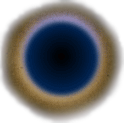In 1971/2 an artist friend, Paul Marchant, a student of Keith Critchlow, introduced me to a book called “Sensitive Chaos” by Hans Jenny. Jenny writes of his exploration of the effect of sound waves on normally “chaotic” particles such as water molecules or fine dust and describes the organised patterns that result as a phenomenon called Cymatics.
As I was at that time exploring (amongst other things) the emotional link between film and music, I decided to build an apparatus that caused sound energy to agitate a thin surface of liquid and observed the cymatic patterns Jenny describes. This apparatus became the core link for me between sound/music and light/video, and was an inspirational revelation. This moment co-incided with the introduction of the first monochrome portable video recorders into the UK and I switched my attention to video rather then film – this transition is apparent in my Royal College of Art graduate film Death of Van Gogh? [XXXXXXXXX 2.5.5.4]. My early experiments were in monochrome (some fragments are held in the REWIND archive, but I was soon able to work in colour at the RCA studio.
Following this striking physical demonstration of the vibratory nature of sound, I was led to explore the vibratory nature of light and indeed all perceived phenomena. There is no room here for the science, which is still evolving and keenly debated, but the fundamental particles or elements of both matter and light seem to be easily described in vibratory terms, and our human receptors are finely attuned to these vibratory phenomena. A key popular expression of that late 60s/early70s period was “feel the vibes” . . .
For an artist it is both easy and enormous fruitful to stray freely across the boundaries between art, science and metaphysics and these area have been key arenas for my work. I was and am as free to explore metaphysics as physics and cosmology. We were in a time when the emerging cosmological theory was of a “big bang” and a likely oscillating universe – see astronomer Fred Hoyle – theories since discredited, but now keenly debated again . . . And we were also in a time when the influence of Eastern ways of understanding the universe were far more accessible than in earlier periods.
It does seem very likely that all phenomena, from the tiniest to the the most extreme, have an oscillatory or vibratory aspect. So the link between my interest and exploration of the common ground between vibration in sound and light naturally linked to themes of microscopic and macrocosmic events in the universe [XXXXXXXXXX 2.3.4.5]
